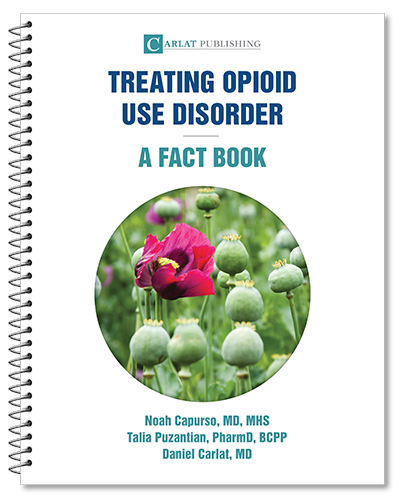Home » Primer: Physical Examination in Addiction Practice
CLINICAL UPDATE
Primer: Physical Examination in Addiction Practice
November 22, 2019
From The Carlat Addiction Treatment Report
Patients with substance use disorders (SUD) often have unaddressed medical issues. As addiction providers, we may be a patient’s only line of contact with health care personnel. Thus, keeping an eye out for medical problems could help reduce associated complications and even save a life. This article will take you through the sections of a basic physical exam, including findings to watch for.
General health
Don’t be surprised if patients present with physical markers of active substance use. This can happen even in settings where you wouldn’t expect it, such as on inpatient units or in the corrections system.
A patient who has relapsed may have alterations in grooming and hygiene. Significant weight changes are also a concerning sign. Next, patients may have evidence of intoxication or withdrawal. These states are accompanied by changes in mental status, characterized by increased arousal, agitation, psychosis, or sedation. Patients can exhibit slurred speech, unsteady gait, pinpoint or dilated pupils, unusual behaviors, sweating, watery eyes, skin picking, or runny nose. These symptoms are nonspecific, however, and can result from many causes. Further inquiry, including a urine toxicology screen and a breathalyzer or blood alcohol level, is a good first step.
Head and neck
Signs of head trauma, leading to subdural hematomas, can occur after falls related to alcohol or drug use and should raise a red flag. Patients might complain of confusion, persistent headaches, or visual changes. Injuries can sometimes, but not always, be noted by visual inspection. Scrapes, scabs, or bruising may be present. Head trauma can also occur from accidents or violence, including domestic violence. Head injuries can be missed in intoxicated patients, for whom physicals are often deferred, so these patients require extra attention.
Turning to the eyes, conjunctival infection is found with cannabis intoxication. Pinpoint pupils are a common finding with opioid use. Nystagmus, abnormal side-to-side eye movements, can occur with a number of substances, including alcohol and phencyclidine (PCP). Abnormal eye movements, along with imbalance and memory problems, are hallmark symptoms of Wernicke’s encephalopathy. This condition requires prompt treatment with IV or IM thiamine to prevent Korsakoff’s syndrome—an irreversible condition leading to permanent memory loss and disability.
Breakdown of the nasal lining and damage to the nasal membranes are signs of intranasal drug use, including long-term cocaine use. Inhalants can cause a “glue-sniffers’ rash” around the nose and mouth.
In examining the mouth, there may be signs of teeth grinding (bruxism) exhibited by worn-down teeth, jaw clenching (trismus), or extreme tooth decay. These can be symptoms of MDMA or amphetamine use. Patients who smoke or drink heavily can have premalignant and malignant oral cavity lesions. Tobacco-stained teeth can serve as a point for tobacco cessation discussions.
Chest
Listening to the lungs can reveal evidence of pneumonia, often heard as crackles in the lung bases. Clinically, patients with pneumonia have high fever, cough, chills, and labored breathing. Pneumonia may be secondary to alcohol-induced aspiration. Respiratory depression occurs with opioid and alcohol use. It can exacerbate sleep apnea and contribute to infections. Tobacco is associated with lung cancer and airway disease.
Vaping and electronic cigarette use have been linked to severe lung injury and are already responsible for 2,172 confirmed and probable lung injury cases in the US, with 42 deaths as of this writing (www.cdc.gov/tobacco/basic_information/e-cigarettes/severe-lung-disease.html). Unless you ask specifically about e-cigarette or vaping product use, this diagnosis may be missed.
Auscultation of the heart can reveal murmurs, providing evidence of valvular damage from injection drug use. Some patients will require valve replacement surgery. A new murmur and fever should raise suspicion of endocarditis, a potentially fatal condition involving inflammation of the inner lining of the heart. Other cardiovascular complications include atrial fibrillation (“holiday heart”), high blood pressure, heart attack, and stroke.
Abdomen
Examination of the liver is recommended to evaluate for complications of alcohol use. Patients with alcohol use disorder may have a small, hard liver consistent with cirrhosis. An enlarged liver could be due to alcohol-induced or viral hepatitis.
Skin
Look for signs of injection drug use, including scars at frequent injection sites—the so-called “track marks.” Sometimes these are obscured by tattoos. Cellulitis and abscesses occur in patients who use IV drugs, especially if needles are reused, dirty, or shared. Abscesses may require antibiotic treatment and incision and drainage. Skin sores and burns on the hands, fingers, and mouth from use of pipes are seen frequently in meth users. Patients with cirrhosis or acute liver failure can have jaundice.
Neurological
A brief cognitive evaluation can reveal memory dysfunction due to chronic alcohol, sedative, or inhalant use. Alcohol can cause neuropathy, while substance intoxication can also result in compression neuropathy, such as “Saturday night palsy.” This is a loss of arm function that occurs due to nerve injury from falling asleep on the arm while heavily intoxicated. Seizures can occur during stimulant intoxication and withdrawal from alcohol and sedative-hypnotics. Tobacco use can result in stroke (Miller SC et al, eds. The ASAM Principles of Addiction Medicine. 6th ed. Philadelphia, PA: Wolters Kluwer, 2018:1110–1111).
CATR Verdict: Persons with SUD often do not receive adequate medical care. Many signs and consequences of substance use can be noted simply by observing patients. Such evaluations provide an opportunity to connect patients to medical care for treatment of complications and prevention of future ones.
Addiction Treatment Clinical UpdateGeneral health
Don’t be surprised if patients present with physical markers of active substance use. This can happen even in settings where you wouldn’t expect it, such as on inpatient units or in the corrections system.
A patient who has relapsed may have alterations in grooming and hygiene. Significant weight changes are also a concerning sign. Next, patients may have evidence of intoxication or withdrawal. These states are accompanied by changes in mental status, characterized by increased arousal, agitation, psychosis, or sedation. Patients can exhibit slurred speech, unsteady gait, pinpoint or dilated pupils, unusual behaviors, sweating, watery eyes, skin picking, or runny nose. These symptoms are nonspecific, however, and can result from many causes. Further inquiry, including a urine toxicology screen and a breathalyzer or blood alcohol level, is a good first step.
Head and neck
Signs of head trauma, leading to subdural hematomas, can occur after falls related to alcohol or drug use and should raise a red flag. Patients might complain of confusion, persistent headaches, or visual changes. Injuries can sometimes, but not always, be noted by visual inspection. Scrapes, scabs, or bruising may be present. Head trauma can also occur from accidents or violence, including domestic violence. Head injuries can be missed in intoxicated patients, for whom physicals are often deferred, so these patients require extra attention.
Turning to the eyes, conjunctival infection is found with cannabis intoxication. Pinpoint pupils are a common finding with opioid use. Nystagmus, abnormal side-to-side eye movements, can occur with a number of substances, including alcohol and phencyclidine (PCP). Abnormal eye movements, along with imbalance and memory problems, are hallmark symptoms of Wernicke’s encephalopathy. This condition requires prompt treatment with IV or IM thiamine to prevent Korsakoff’s syndrome—an irreversible condition leading to permanent memory loss and disability.
Breakdown of the nasal lining and damage to the nasal membranes are signs of intranasal drug use, including long-term cocaine use. Inhalants can cause a “glue-sniffers’ rash” around the nose and mouth.
In examining the mouth, there may be signs of teeth grinding (bruxism) exhibited by worn-down teeth, jaw clenching (trismus), or extreme tooth decay. These can be symptoms of MDMA or amphetamine use. Patients who smoke or drink heavily can have premalignant and malignant oral cavity lesions. Tobacco-stained teeth can serve as a point for tobacco cessation discussions.
Chest
Listening to the lungs can reveal evidence of pneumonia, often heard as crackles in the lung bases. Clinically, patients with pneumonia have high fever, cough, chills, and labored breathing. Pneumonia may be secondary to alcohol-induced aspiration. Respiratory depression occurs with opioid and alcohol use. It can exacerbate sleep apnea and contribute to infections. Tobacco is associated with lung cancer and airway disease.
Vaping and electronic cigarette use have been linked to severe lung injury and are already responsible for 2,172 confirmed and probable lung injury cases in the US, with 42 deaths as of this writing (www.cdc.gov/tobacco/basic_information/e-cigarettes/severe-lung-disease.html). Unless you ask specifically about e-cigarette or vaping product use, this diagnosis may be missed.
Auscultation of the heart can reveal murmurs, providing evidence of valvular damage from injection drug use. Some patients will require valve replacement surgery. A new murmur and fever should raise suspicion of endocarditis, a potentially fatal condition involving inflammation of the inner lining of the heart. Other cardiovascular complications include atrial fibrillation (“holiday heart”), high blood pressure, heart attack, and stroke.
Abdomen
Examination of the liver is recommended to evaluate for complications of alcohol use. Patients with alcohol use disorder may have a small, hard liver consistent with cirrhosis. An enlarged liver could be due to alcohol-induced or viral hepatitis.
Skin
Look for signs of injection drug use, including scars at frequent injection sites—the so-called “track marks.” Sometimes these are obscured by tattoos. Cellulitis and abscesses occur in patients who use IV drugs, especially if needles are reused, dirty, or shared. Abscesses may require antibiotic treatment and incision and drainage. Skin sores and burns on the hands, fingers, and mouth from use of pipes are seen frequently in meth users. Patients with cirrhosis or acute liver failure can have jaundice.
Neurological
A brief cognitive evaluation can reveal memory dysfunction due to chronic alcohol, sedative, or inhalant use. Alcohol can cause neuropathy, while substance intoxication can also result in compression neuropathy, such as “Saturday night palsy.” This is a loss of arm function that occurs due to nerve injury from falling asleep on the arm while heavily intoxicated. Seizures can occur during stimulant intoxication and withdrawal from alcohol and sedative-hypnotics. Tobacco use can result in stroke (Miller SC et al, eds. The ASAM Principles of Addiction Medicine. 6th ed. Philadelphia, PA: Wolters Kluwer, 2018:1110–1111).
CATR Verdict: Persons with SUD often do not receive adequate medical care. Many signs and consequences of substance use can be noted simply by observing patients. Such evaluations provide an opportunity to connect patients to medical care for treatment of complications and prevention of future ones.
KEYWORDS addiction comorbidity medical_comorbidities prevention psychosomatics substance-use substance-use-disorders
Issue Date: November 22, 2019
Table Of Contents
Recommended
Newsletters
Please see our Terms and Conditions, Privacy Policy, Subscription Agreement, Use of Cookies, and Hardware/Software Requirements to view our website.
© 2025 Carlat Publishing, LLC and Affiliates, All Rights Reserved.


_-The-Breakthrough-Antipsychotic-That-Could-Change-Everything.jpg?1729528747)



